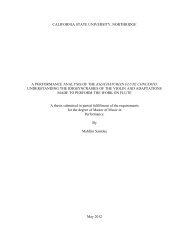2644 - CSUN ScholarWorks - California State University, Northridge
2644 - CSUN ScholarWorks - California State University, Northridge
2644 - CSUN ScholarWorks - California State University, Northridge
You also want an ePaper? Increase the reach of your titles
YUMPU automatically turns print PDFs into web optimized ePapers that Google loves.
66 · Journal of Student Research Abstracts<br />
other dish. This indicates that at such a low water depth (1/4 em), the planarians were extremely vulnerable to<br />
ultraviolet radiation compared to the larger depth (1 1/4 em). It was found that there was a significant difference<br />
(p>.001) between planarian deaths from ultraviolet radiation at a low water depth (1/4 em) and at a greater<br />
depth (1 1/4 em). Also, at the same water depths ("Control 1/4" & "Radiated 1/4" and "Radiated 1 1/4" &<br />
"Control 1 114") there was a significant difference (p>.001) between deaths of the "Radiated" planarians and<br />
the "Control" planarians. This means that the fatalities were caused by only the radiation and not by any other<br />
factor.<br />
2788<br />
SNAil TRAILS: Will A SNAil FOllOW ANOTHER SNAIL'S MUCUS TRAil?<br />
RobertS. Dong, Steve DeGusta (teacher). John F. Kennedy High School, 6715 Gloria Dr. , Sacramento, CA<br />
95831.<br />
I investigated the behavior of the common land snail, Cepaea nemoralis, when presented with a mucus trail<br />
created by another snail. To do this, I obtained a "T" shaped maze and built a zigzag shaped maze. Using these<br />
mazes, I set up tests to determine if snails would follow the trails. The 1st test used the "T" maze. A snail would<br />
leave a mucus trail leading towards one direction. A 2nd snail would then be placed at the beginning of the<br />
trail to see if it would follow it. ON all the trials, the snails followed the trails direction. From this portion of<br />
my experiment, it was proven that snails would follow another mucus trail when given a choice between no<br />
trail and a trail.<br />
The zigzag maze was used next as further proof that they will follow the trail. To do this, one snail would<br />
be placed at the beginning of the maze. The snail then made a trail in a zigzag shape. A 2nd snail was then<br />
placed at the starting point without a maze to guide it. This way, the snail has an unlimited choice as to where<br />
to go. This also proved successful, as the snails followed each other's mucus trails. They would not follow the<br />
trail however, if there was an extreme source of heat or light upon the trail.<br />
2789<br />
EFFECTS OF STEINERNEMA NEMATODES ON TOBACCO HORNWORMS.<br />
Rudy Buehler and Steve DeGusta (teacher). John F. Kennedy High School, 6715 Gloria Drive, Sacramento,<br />
CA 95831.<br />
This study was conducted to find out if the nematodes Steinemema were effective as pest control on tobacco<br />
homworms (Manduca sexta) and on their cocoons. I tested the hornworms in their larval stage first. The<br />
nematodes were placed in the soil. In nature, the nematodes are able to make their way into the bodies of their<br />
victims and kill them within 48 hours. In this study, they did not. All 20 experimental homworms survived.<br />
The second study was testing the nematodes on the cocoon stage of the homworms. I injected the nematodes<br />
directly into the cocoons by way of a 26G needle tip on a 1 cc syringe. The 12 experimental cocoons were dead<br />
within 48 hours while the 12 control cocoons, which were not injected with nematodes, survived. The controls<br />
were stuck with a needle but received no injection. The control cocoons later hatched into tobacco moths while<br />
the experimental cocoons did not. The nematodes effectively killed the cocoons of the homworm.













